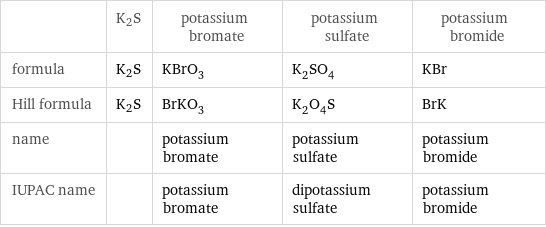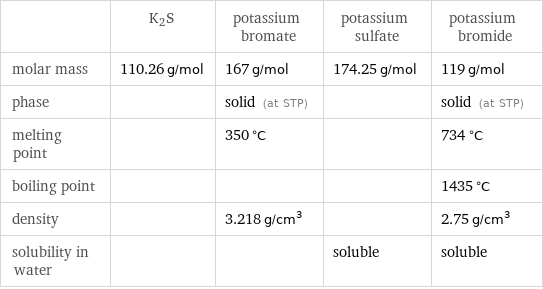Input interpretation

K2S + KBrO_3 potassium bromate ⟶ K_2SO_4 potassium sulfate + KBr potassium bromide
Balanced equation

Balance the chemical equation algebraically: K2S + KBrO_3 ⟶ K_2SO_4 + KBr Add stoichiometric coefficients, c_i, to the reactants and products: c_1 K2S + c_2 KBrO_3 ⟶ c_3 K_2SO_4 + c_4 KBr Set the number of atoms in the reactants equal to the number of atoms in the products for K, S, Br and O: K: | 2 c_1 + c_2 = 2 c_3 + c_4 S: | c_1 = c_3 Br: | c_2 = c_4 O: | 3 c_2 = 4 c_3 Since the coefficients are relative quantities and underdetermined, choose a coefficient to set arbitrarily. To keep the coefficients small, the arbitrary value is ordinarily one. For instance, set c_1 = 1 and solve the system of equations for the remaining coefficients: c_1 = 1 c_2 = 4/3 c_3 = 1 c_4 = 4/3 Multiply by the least common denominator, 3, to eliminate fractional coefficients: c_1 = 3 c_2 = 4 c_3 = 3 c_4 = 4 Substitute the coefficients into the chemical reaction to obtain the balanced equation: Answer: | | 3 K2S + 4 KBrO_3 ⟶ 3 K_2SO_4 + 4 KBr
Structures

K2S + ⟶ +
Names

K2S + potassium bromate ⟶ potassium sulfate + potassium bromide
Equilibrium constant
![Construct the equilibrium constant, K, expression for: K2S + KBrO_3 ⟶ K_2SO_4 + KBr Plan: • Balance the chemical equation. • Determine the stoichiometric numbers. • Assemble the activity expression for each chemical species. • Use the activity expressions to build the equilibrium constant expression. Write the balanced chemical equation: 3 K2S + 4 KBrO_3 ⟶ 3 K_2SO_4 + 4 KBr Assign stoichiometric numbers, ν_i, using the stoichiometric coefficients, c_i, from the balanced chemical equation in the following manner: ν_i = -c_i for reactants and ν_i = c_i for products: chemical species | c_i | ν_i K2S | 3 | -3 KBrO_3 | 4 | -4 K_2SO_4 | 3 | 3 KBr | 4 | 4 Assemble the activity expressions accounting for the state of matter and ν_i: chemical species | c_i | ν_i | activity expression K2S | 3 | -3 | ([K2S])^(-3) KBrO_3 | 4 | -4 | ([KBrO3])^(-4) K_2SO_4 | 3 | 3 | ([K2SO4])^3 KBr | 4 | 4 | ([KBr])^4 The equilibrium constant symbol in the concentration basis is: K_c Mulitply the activity expressions to arrive at the K_c expression: Answer: | | K_c = ([K2S])^(-3) ([KBrO3])^(-4) ([K2SO4])^3 ([KBr])^4 = (([K2SO4])^3 ([KBr])^4)/(([K2S])^3 ([KBrO3])^4)](../image_source/7680823be66d8b61855334ad7ac60f5c.png)
Construct the equilibrium constant, K, expression for: K2S + KBrO_3 ⟶ K_2SO_4 + KBr Plan: • Balance the chemical equation. • Determine the stoichiometric numbers. • Assemble the activity expression for each chemical species. • Use the activity expressions to build the equilibrium constant expression. Write the balanced chemical equation: 3 K2S + 4 KBrO_3 ⟶ 3 K_2SO_4 + 4 KBr Assign stoichiometric numbers, ν_i, using the stoichiometric coefficients, c_i, from the balanced chemical equation in the following manner: ν_i = -c_i for reactants and ν_i = c_i for products: chemical species | c_i | ν_i K2S | 3 | -3 KBrO_3 | 4 | -4 K_2SO_4 | 3 | 3 KBr | 4 | 4 Assemble the activity expressions accounting for the state of matter and ν_i: chemical species | c_i | ν_i | activity expression K2S | 3 | -3 | ([K2S])^(-3) KBrO_3 | 4 | -4 | ([KBrO3])^(-4) K_2SO_4 | 3 | 3 | ([K2SO4])^3 KBr | 4 | 4 | ([KBr])^4 The equilibrium constant symbol in the concentration basis is: K_c Mulitply the activity expressions to arrive at the K_c expression: Answer: | | K_c = ([K2S])^(-3) ([KBrO3])^(-4) ([K2SO4])^3 ([KBr])^4 = (([K2SO4])^3 ([KBr])^4)/(([K2S])^3 ([KBrO3])^4)
Rate of reaction
![Construct the rate of reaction expression for: K2S + KBrO_3 ⟶ K_2SO_4 + KBr Plan: • Balance the chemical equation. • Determine the stoichiometric numbers. • Assemble the rate term for each chemical species. • Write the rate of reaction expression. Write the balanced chemical equation: 3 K2S + 4 KBrO_3 ⟶ 3 K_2SO_4 + 4 KBr Assign stoichiometric numbers, ν_i, using the stoichiometric coefficients, c_i, from the balanced chemical equation in the following manner: ν_i = -c_i for reactants and ν_i = c_i for products: chemical species | c_i | ν_i K2S | 3 | -3 KBrO_3 | 4 | -4 K_2SO_4 | 3 | 3 KBr | 4 | 4 The rate term for each chemical species, B_i, is 1/ν_i(Δ[B_i])/(Δt) where [B_i] is the amount concentration and t is time: chemical species | c_i | ν_i | rate term K2S | 3 | -3 | -1/3 (Δ[K2S])/(Δt) KBrO_3 | 4 | -4 | -1/4 (Δ[KBrO3])/(Δt) K_2SO_4 | 3 | 3 | 1/3 (Δ[K2SO4])/(Δt) KBr | 4 | 4 | 1/4 (Δ[KBr])/(Δt) (for infinitesimal rate of change, replace Δ with d) Set the rate terms equal to each other to arrive at the rate expression: Answer: | | rate = -1/3 (Δ[K2S])/(Δt) = -1/4 (Δ[KBrO3])/(Δt) = 1/3 (Δ[K2SO4])/(Δt) = 1/4 (Δ[KBr])/(Δt) (assuming constant volume and no accumulation of intermediates or side products)](../image_source/dcff7b847e5ba132f8abd10ab4dcbdfa.png)
Construct the rate of reaction expression for: K2S + KBrO_3 ⟶ K_2SO_4 + KBr Plan: • Balance the chemical equation. • Determine the stoichiometric numbers. • Assemble the rate term for each chemical species. • Write the rate of reaction expression. Write the balanced chemical equation: 3 K2S + 4 KBrO_3 ⟶ 3 K_2SO_4 + 4 KBr Assign stoichiometric numbers, ν_i, using the stoichiometric coefficients, c_i, from the balanced chemical equation in the following manner: ν_i = -c_i for reactants and ν_i = c_i for products: chemical species | c_i | ν_i K2S | 3 | -3 KBrO_3 | 4 | -4 K_2SO_4 | 3 | 3 KBr | 4 | 4 The rate term for each chemical species, B_i, is 1/ν_i(Δ[B_i])/(Δt) where [B_i] is the amount concentration and t is time: chemical species | c_i | ν_i | rate term K2S | 3 | -3 | -1/3 (Δ[K2S])/(Δt) KBrO_3 | 4 | -4 | -1/4 (Δ[KBrO3])/(Δt) K_2SO_4 | 3 | 3 | 1/3 (Δ[K2SO4])/(Δt) KBr | 4 | 4 | 1/4 (Δ[KBr])/(Δt) (for infinitesimal rate of change, replace Δ with d) Set the rate terms equal to each other to arrive at the rate expression: Answer: | | rate = -1/3 (Δ[K2S])/(Δt) = -1/4 (Δ[KBrO3])/(Δt) = 1/3 (Δ[K2SO4])/(Δt) = 1/4 (Δ[KBr])/(Δt) (assuming constant volume and no accumulation of intermediates or side products)
Chemical names and formulas

| K2S | potassium bromate | potassium sulfate | potassium bromide formula | K2S | KBrO_3 | K_2SO_4 | KBr Hill formula | K2S | BrKO_3 | K_2O_4S | BrK name | | potassium bromate | potassium sulfate | potassium bromide IUPAC name | | potassium bromate | dipotassium sulfate | potassium bromide
Substance properties

| K2S | potassium bromate | potassium sulfate | potassium bromide molar mass | 110.26 g/mol | 167 g/mol | 174.25 g/mol | 119 g/mol phase | | solid (at STP) | | solid (at STP) melting point | | 350 °C | | 734 °C boiling point | | | | 1435 °C density | | 3.218 g/cm^3 | | 2.75 g/cm^3 solubility in water | | | soluble | soluble
Units
